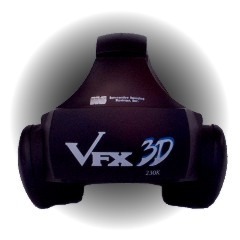
March 03, 2000: IIS VFX3D - First test drive
Finally tried it! First of all the tracking is quite smooth. There were no 'big jumps' as in older trackers. It allows full turns and an almost straight view to the ceiling and floor. The specs say the vertical range is +/- 70°, but I had almost a 90°-feeling.
The helmet isn't light, but well balanced. There's a single, extra-long cable which gives enough freedom even in stand-up position.
The optics can be used with large prescribed
glasses and don't require much adjustment. There seems to be no focus control.
The image always stayed focused.
The view isn't much immersive, but at
least it's quite relaxing to the eyes. I own a HMD which is more immersive
- the CyberMaxx - but the strong wide-angle optics suck my eyes out ot
the skull.
Image quality and resolution is O.K.,
but far from satifying. At least I was able to see most details of the
640x480 source image.
I couldn't see that much of a stereo-effect,
but I doubt the HMD is to blame here. I suspect that the universal-D3D-driver
has problems, but I will determine that later when my sample arrives. Universal
D3D-stereo-driver programming is an art which until now only ELSA and to
some extent Wicked3D were able to master.
The standard stereo-mode for the VFX3D
is 640x480, so it becomes apparend that the resolution is cut into half
in stereo-mode. (263x240 opposed to 263x480 in mono per eye).
Also presented at CeBIT was the 'INCAD' stereo & tracking plug-in for 3D Studio Max.
You may also check the short VFX3D report
by Peter Schmitz and me, in german language, on the c't-Newsticker
of March 1st.
